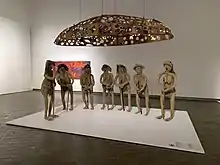Tjanpi Desert Weavers
Tjanpi Desert Weavers is a social enterprise of the NPY Women’s Council,[1] representing over 400 women from 26 unique communities[2] in the NPY (Ngaanyatjarra, Pitjantjatjara and Yankunytjatjara) region. Tjanpi is the Pitjantjatjara word for a type of spinifex grass. The weavers harvest and weave local grasses and some other materials to create handmade works and pieces of art.[3] In producing these works, which mostly consist of baskets, jewellery, beads and fibre sculpture, the enterprise encourages women's employment and economic independence.[3]
History
Grass weaving is not a traditional pursuit in Central Australia,[4] but once shown the basics in 1995,[5] the women quickly applied their existing skills in spinning human hair, animal fur, string and wool.[3] By building on these existing skills, and working together, the Tjanpi weavers maintain a strong cultural connection and connection to each other and, as a part of the program, the women come together to collect grass for their art as well as hunt, gather food, visit sacred sites, perform inma (cultural song and dance), and teach younger people.[2]
The social enterprise of the work also enables the women to 'stay on Country' and, as one senior artist says:[1]
We don't have to leave our lands to be basket makers
— Paniny Mick, Tjanpi Desert Weavers
The Tjanpi have a public gallery in Alice Springs.[6]
Exhibitions and awards

The Tjanpi Desert Weavers are represented in national and international public and private art collections.[7][8] In 2005 a collective of 18 artists won the Telstra National Aboriginal and Torres Strait Islander Art Award for their work Tjanpi Toyota.[9]
A collaborative work between Tjanpi Desert Weavers and artist Fiona Hall, Kuka Irititja (Animals from Another Time), originally created for the TarraWarra Biennial,[10] formed part of the 2015 Venice Biennale.[11][12] A major project with the National Museum of Australia, led to the work, Kungkarrangkalnga-ya Parrpakanu (The Seven Sisters Are Flying) in 2017.[13] [14]
A large-scale installation, telling the story of Kungkarangkalpa (Seven Sisters Dreaming) was commissioned as a feature of the National Gallery of Australia's 2020 Know My Name Exhibition.[15]
Artists
Tjanpi Desert Weaver artists include the following artists:[8]
- Kanytjupayi Benson
- Nyurpaya Kaika-Burton
- Roma Butler[16]
- Yangi Yangi Fox[16]
- Niningka Lewis
- Paniny Mick
- Mary Katatjuku Pan
- Tjunkaya Tapaya
- Carlene Thompson
- Ilawanti Ungkutjuru
- Yaritji Young
References
- "Tjanpi Desert Weavers". Tjanpi Desert Weavers. Retrieved 22 October 2019.
- "Tjanpi Desert Weavers". NPY Women's Council. Retrieved 22 October 2019.
- Watson, Penny. (2012). Tjanpi desert weavers. Ngaanyatjarra Pitjantjatjara Yankunytjatjara Women's Council Aboriginal Corporation. Sydney: Macmillan Art Publishing. ISBN 9781921394461. OCLC 792762384.
- Flynn, Eugenia; Onus, Tiriki. "The Tjanpi Desert Weavers show us that traditional craft is art". The Conversation. Retrieved 28 October 2019.
- Whiting, Natalie (1 October 2015). "Desert weaving puts food on tables in remote communities". ABC News. Retrieved 28 October 2019.
- "Tjanpi Desert Weavers". Northern Territory. Tourism NT. Retrieved 13 November 2020.
- Cerabona, Ron (25 May 2019). "Showing the songline of Seven Sisters and a shape-shifter". The Canberra Times. Retrieved 28 October 2019.
- "Tjanpi Desert Weavers | MCA Australia". www.mca.com.au. Retrieved 22 October 2019.
- "Tjanpi Toyota". NPY Women's Council. Retrieved 28 October 2019.
- Eccles, Jeremy (5 May 2015). "Mitzevich goes bush". Aboriginal Art Directory. Retrieved 13 November 2020.
- Biddle, Jennifer L. (2 October 2019). "Tjanpi Desert Weavers and the Art of Indigenous Survivance". Australian Feminist Studies. 34 (102): 413–436. doi:10.1080/08164649.2019.1697179.
- "A Minefield of Madness, Badness, and Sadness". Aboriginal Art Directory. 14 May 2015. Retrieved 13 November 2020.
- "Songlines: Tracking the Seven Sisters". National Museum of Australia. Retrieved 13 November 2020.
- "Kungkarrangkalnga-ya Parrpakanu Seven Sisters are flying". ABC News. 14 September 2017. Retrieved 13 November 2020.
- Bell, Delia (9 October 2020). "Tjanpi Desert Weavers celebrated at National Art Gallery exhibition". NITV. Retrieved 13 November 2020.
- "Tjanpi Desert Weavers". National Gallery of Australia. Retrieved 13 November 2020.